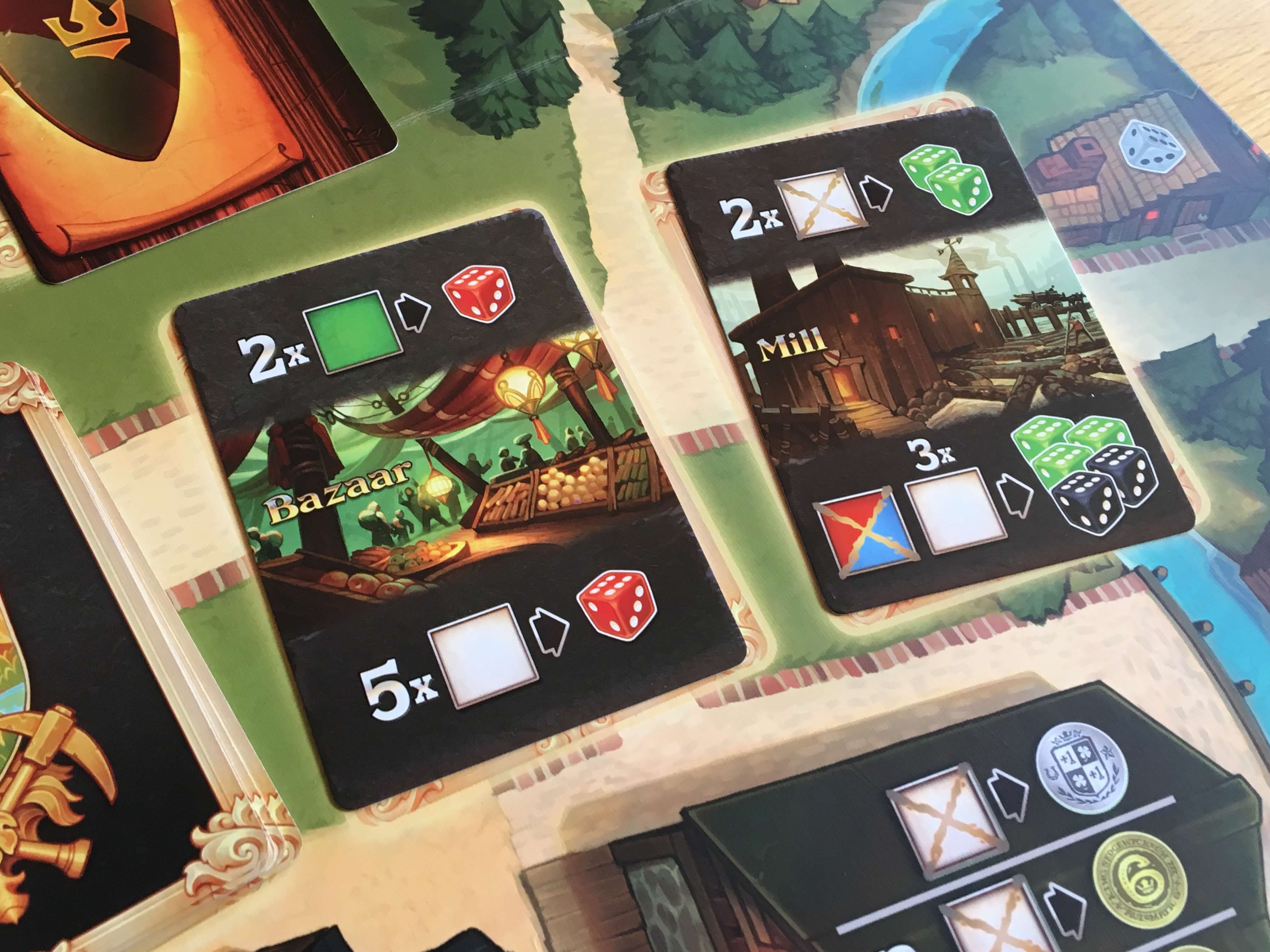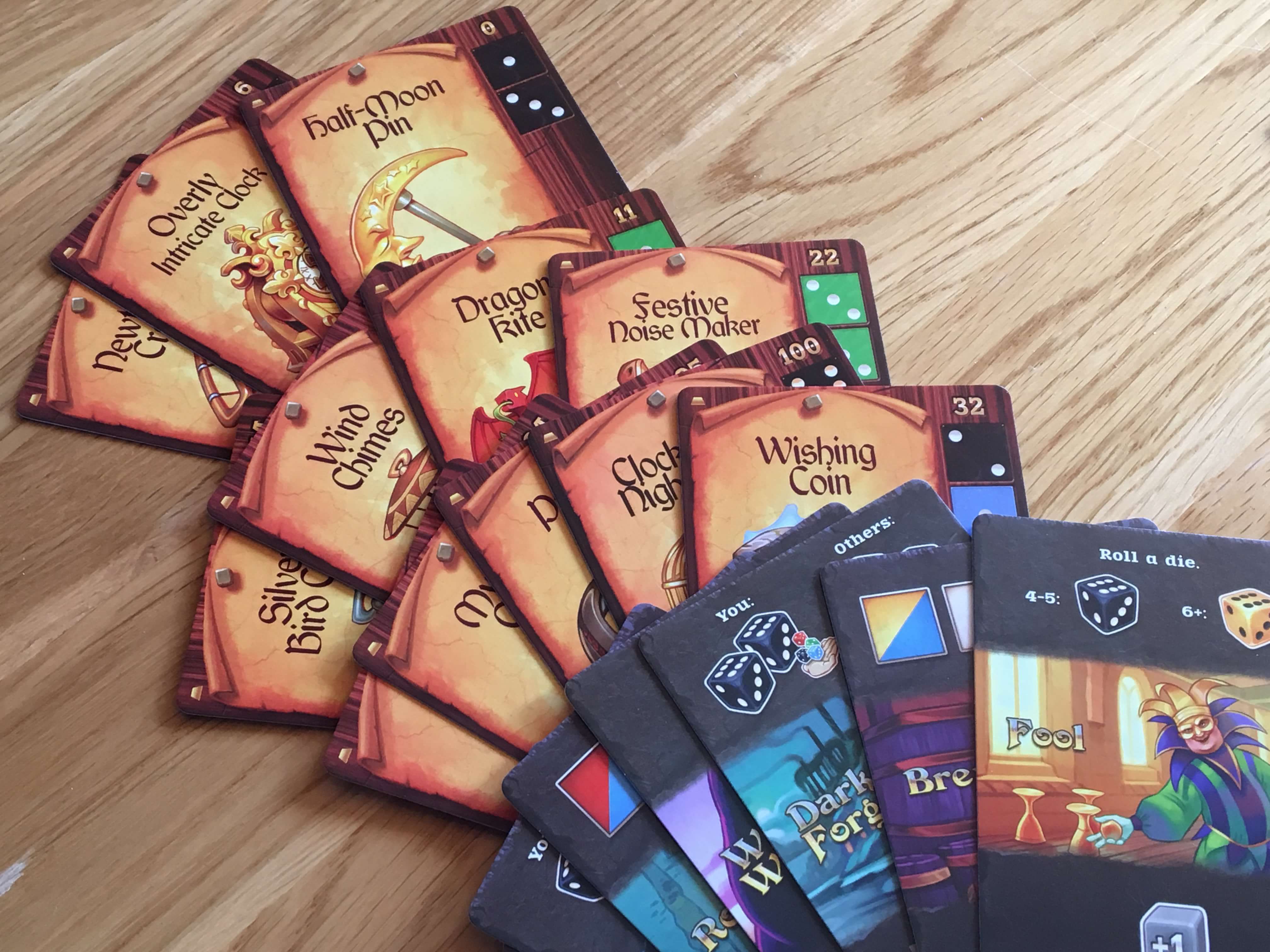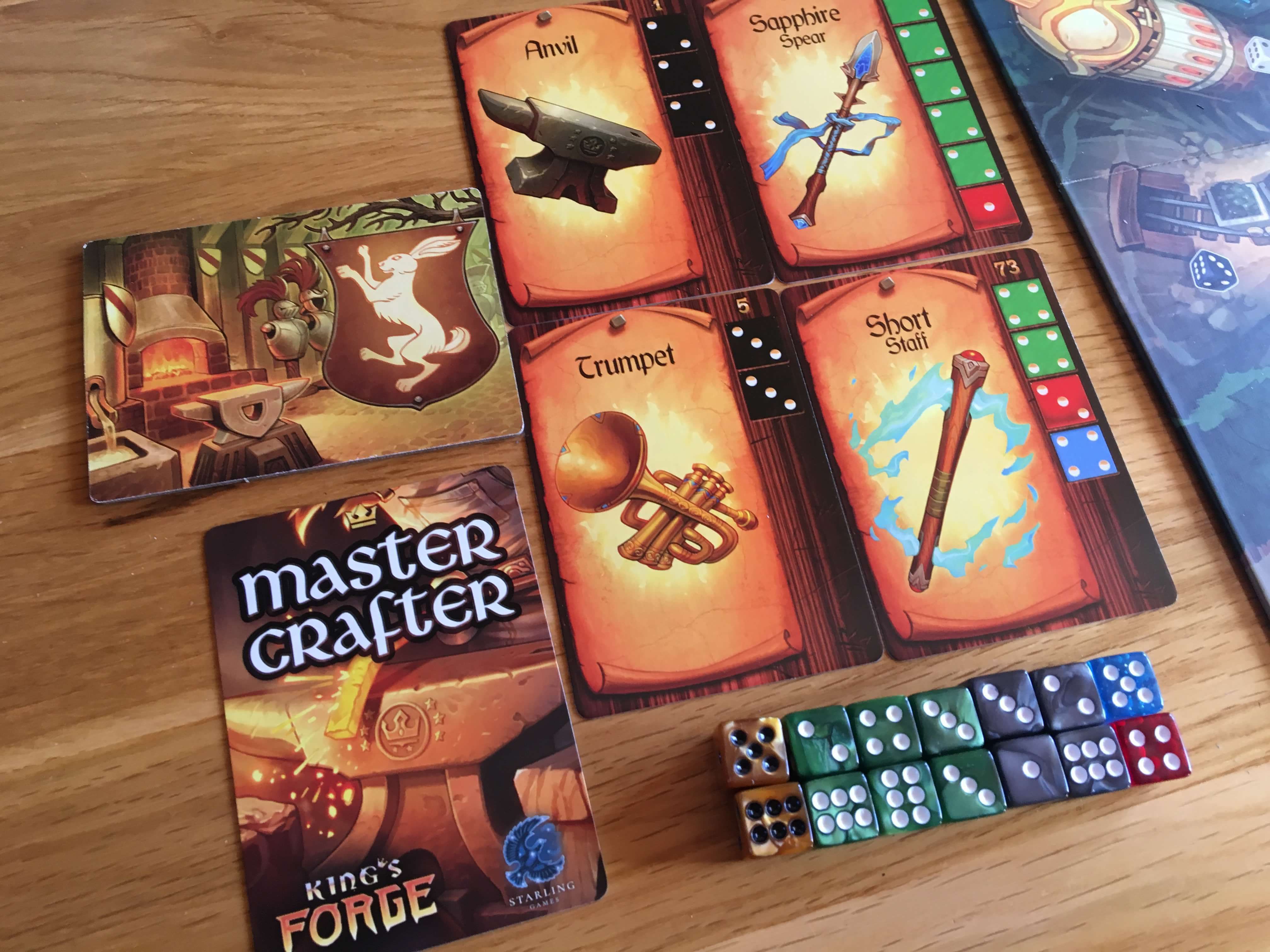![]()
- King’s Forge, which has just been restocked after its third print run, is a popular and fun dice drafting game that encourages the players to act as blacksmiths on a mission to craft the most impressive items as fast as possible. They have good reason to do so, since The King’s chamberlain has promised to appoint the best of them to be the new Craftmaster. King’s Forge is simple to pick up, fast to play and more or less guaranteed to be wrapped up in under an hour.
Overview and turn structure
The object of King’s Forge is to be the first player to craft four items, each of which will require dice of a specific colour and face to be achieved on a roll. The first player to craft four items will win, or if more than one player crafts their fourth item on the same turn, then whoever crafts the highest numbered item will take the game. Unlike in most games these days, there are no hidden or additional objectives, and that makes King’s Forge a very pure and relatively straightforward experience.
Set up is perhaps the most daunting part of the game, although it’s simple once you have been through it a few times. In short, the players will each take a forge mat and six basic metal (black) dice. The main board will be placed in the centre of the table and then the large quantities of black, green, blue and red dice will be placed onto it. A unique feature of King’s Forge is that the board is almost purely cosmetic, which means that King’s Forge can be played in a portable variant that uses four tiles to represent the only mandatory functions on the board.
The rest of game set up focuses on the complex bits, which are randomising the gather locations (of which there will usually be eleven) and the item cards, the number of which will vary depending on player count. The gather locations will always feature four basic cards (plus possibly more, depending on expansions) and then a number of additional locations chosen at random. These will form a deck that will be exhausted and reshuffled several times during each game and because no single game will feature all of the locations, variety is ensured. Where the item cards are concerned, the deck is shuffled, drawn and placed face up on the board in ascending number order (placing the most complex designs to the right).

There are then two phases to every round, with the the first being Gather and the second, Craft. Both of these phases use the same dice resources as each other, which introduces an element of strategy — invest heavily in gathering and you may not be able to craft, but in later turns, you’ll likely have far more resources than your opponents. Firstly, during the Gather phase, each player may take one action from one of the four face up gather locations, or one of the four ports. Usually, these actions involve taking the card in question and then placing the pictured number of dice on one of the options shown. The action taken may provide additional dice, in which case they are taken immediately and added to the players forge (for use in the next round, but not this one). Other effects might allow a dice face to be changed, in which case the card itself is the prompt to do so.
The gather phase goes on for as long as players can afford (and wish) to keep investing, with players taking one action at a time. When everyone passes, the crafting phase begins and the players will roll any dice they have that were not invested in gathering. Remember that any dice drawn in the gather phase that just ended can’t be used this round either, which again is all part of the strategic puzzle. With the dice rolled and the face values shown, players will assess the first three item cards and if they have the resources to craft one of them, then they may do so by taking the item and placing their crafting dice on it.
Now, just because an item card is in front of another player, it doesn’t meant that they have crafted it — yet — even though an additional item card will now be made available for crafting. If any other player can deliver the same resources, but with higher die faces showing, then they can steal the item — indicating that The Chamberlain is more impressed by their version of the same item. Once all players have crafted (or passed) then the first player token moves on and the next round begins with a new gather phase. After about seven to nine rounds, the game will usually end and it’s fairly frequent that a couple of players will make it to four items on the same turn, so prioritising higher numbered items is a sound tactic.

Components
In this printing of King’s Forge, the game has been produced to a high standard overall, but may seem less impressive in terms of the sheer volume of content when compared to some of the flashier Kickstarters that are popular at the moment. The board looks good and is very clear, as are the four port tiles that can be used to replace it when playing on the move or on a small table. The manual is clear, informative and generally very good — although it would have been hard to make a mess of explaining such a simple game.
The main areas of interest therefore are the gather and item cards, as well as the dice that are so integral to the game. The item cards are sort of plain, with basic, identical backgrounds that make a feature of the actual item in question. This is one of the areas in which King’s Forge shines — I really love the inventiveness of some of the items, especially in the Gold expansion, which more or less doubles the total number of items that players can craft. Everything from trumpets and basic swords to ornate clocks and exquisite pieces of jewelry are included, and the art is bright and imaginative for the most part.
I didn’t feel that the gather cards were up to the same standard, unfortunately, since they are predominantly black and the artwork on them is limited to about forty to fifty percent of the space. Perhaps more concerning is the fact that what artwork there is lacks thematic power — you can tell that a forest is a forest or that a mine is a mine, but even the more interesting locations are depicted in a fairly dull manner. There are also too few of them in the base game I think, though again, Gold (which is just one of many expansions) corrects that in fairly short order.
Finally, the dice in King’s Forge are a little smaller than most, but there are tons and tons and tons of them to make up for it. With Gold added into the mix, the range of colours is impressive and the quality of each and every die is top notch — my copy has zero flawed pieces in it. I guess the size makes the dice less satisfying to fiddle with and roll than some, but King’s Forge isn’t the sort of game that you’ll spend clutching the same dice — there’s a fair bit of rolling and placing to keep you occupied, to the extent that I’m only really thinking about the dice from the perspective of a critical analysis.

Game Experience
King’s Forge is the kind of game that I love to play, but it also has its limitations in terms of depth and replay value among some of the groups I attend. King’s Forge is an inherently light game that has elements of both basic drafting and plain, old fashioned luck mated with a simple scoring mechanism. As such, I often use King’s Forge to warm up or finish an evening, but whenever I am playing with friends who enjoy heavier games, we tend to find it a little basic — partly because of the gameplay, but also because of the relatively limited number of basic gather locations. By contrast, King’s Forge is a superb alternative to traditional gateway games and it makes an unusual and enjoyable addition to most game shelves.
The scoring simplicity that I’ve mentioned a few times is a blessing in that it really does focus the players and make for a tight and competitive experience from start to finish. When looking at still images, and reading the rules, it’s easy to imagine that reaching four items is easy — but it’s never as simple as it looks. Early items rapidly disappear (usually to different players) meaning that mid to late game items become the focus very early on. In almost all cases, these will require two or three dice that you won’t begin the game with, which leads to some really interesting choices between the Gather and Craft phases.
Interestingly, Gold addresses a few of the issues that I think King’s Forge has – the lack of gather locations for example, as well as the basic nature of the ruleset overall. Gold introduces a whole host of variant options that can actually make the game simpler (though I didn’t test them) or more complex. The actual gold dice work slightly differently than the other basic dice and can be used to craft either very special items, or as substitutes for other resources. I feel like my own next move with King’s Forge will be to further expand it, since I think the more variable it is, the more exciting I will find it.

Conclusion
King’s Forge is an enjoyable light to midweight experience that can certainly entertain players of all experience levels for a period of time. Sure, I think it’s likely to be less popular with fans of heavier games, but that doesn’t mean that King’s Forge isn’t enjoyable for the odd game here or there. The Gold expansion, at least, materially increases the variability of the game, which leads me to believe that the other expansions will have a similar effect that will cumulatively make King’s Forge a really variable and highly replayable game. Some of the components let it down slightly, but certainly not to the extent that I think it should put you off — I would just have loved to see more art and perhaps a bit more content in the base game.
Overall, I think King’s Forge is a really nice addition to any game shelf, especially if you are looking for a game that is only around an hour long, but still features some interesting decisions. King’s Forge is also a great game to have if you need to teach lots of different groups of friends — since it can be picked up and played very, very quickly. Being experienced at it helps, but not to the extent that new players will feel cheated, so again, it really is a great gateway game.
A copy of King’s Forge was provided for review purposes. You can find out more about it on the website of publisher Starling Games, or via Amazon.

Hi, I’m Chris Schreiber, the designer of the Gold expansion. I’m so glad you enjoyed King’s Forge and the additional content in Gold. New items and gather cards are always the most important thing to me in each of the expansions. We actually just finished the Kickstarter for the 5th and final King’s Forge expansion, Masterworks.
You might find it interesting that one of my goals for masterworks was bigger gather card art! I have always loved the art, but wanted to see more of it. You’ll be happy to know there’s going to be full-art gather locations in Masterworks. There’s even more choices now during gathering with an extra row of Visitors Cards coming to the kingdom from around the world. Here’s a sample of what the full-art Visitor cards will look like — http://bit.ly/MWgather
Hi Chris,
Thanks for seeking us out and commenting – the full size art sounds awesome. I could see myself playing King’s Forge with more add-ons in the future, such is the simple way that they seem to fold into the game. I’m not sure what options there are for running more than one etc, but I’ll look into the details a bit more! 🙂
Good luck with Masterworks – I’ll pop on over and have a read now!
Rgds
Matt